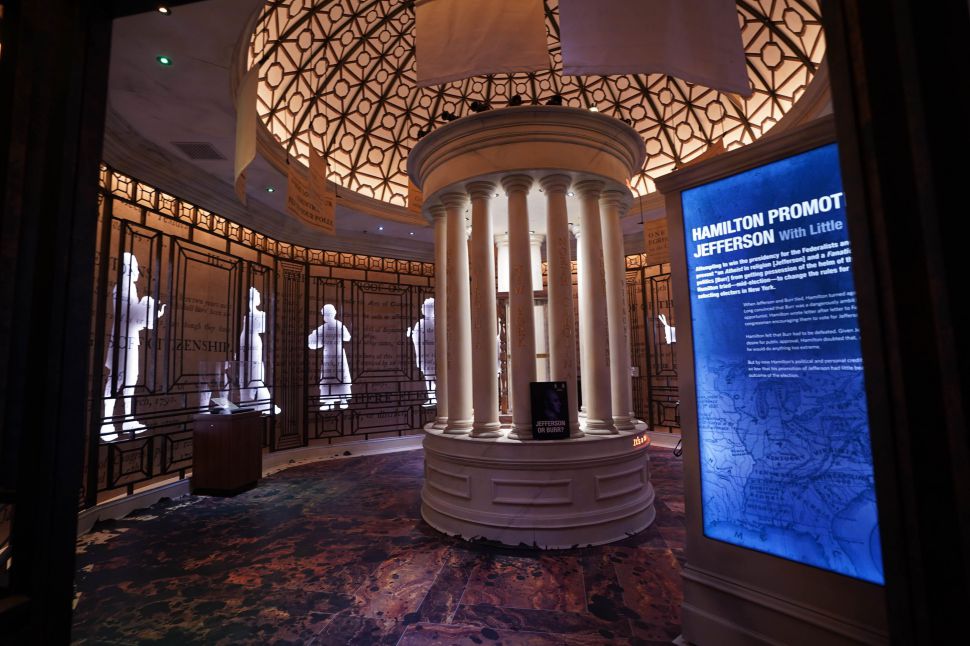Creators of the Broadway musical Hamilton aren’t done giving their man his shot. Responding to audience demand for more, they partnered with manufacturers, integrators, and historians to create the traveling showcase Hamilton: The Museum Exhibition. The technological spectacle thoughtfully presents an immersive exhibit blending art, history, and education surrounding Alexander Hamilton, our country’s founding fathers, and the events of the American Revolution.
Hamilton: The Museum Exhibition is a collaboration among Hamilton creator Lin-Manuel Miranda, director Thomas Kail, creative director and set designer David Korins, producer Jeffrey Seller, orchestrator Alex Lacamoire, and Yale University historian and historical advisor to the exhibit Joanne B. Freeman. Harvard Law professor and historian Annette Gordon-Reed provided historical consultation.
To match the musical’s high production values, creators of this Hamilton project partnered with exhibition consultants IMG and integrator Design Electronics (DE). The exhibit, which opened in Chicago in April, is enjoying wide critical acclaim for the way its creators were able to blend art, history, drama, and education into one spectacular experience.
DE took on the challenge of telling Hamilton’s story and chronicling the American Revolution with a dynamic and interactive mix of lighting, sound, multimedia, music, and educational tidbits. The team—seasoned veterans of museum exhibitions including three iterations of King Tut and the Lady Diana exhibit—chose to re-create a series of rooms and scenes highlighting the pivotal events in Hamilton’s life, many of which are depicted in the musical. The exhibition takes the events and history deeper without the time constraints of the musical.
Environmental Challenges
Hamilton: The Museum Exhibition was an exceptional endeavor from the outset. The first challenge was constructing the 35,000-square-foot metal structure that houses the exhibition in a manner that would support travel. The idea is that the exhibit and its housing travel together around the country rather than being installed in existing museum spaces at each stop on the tour. Design Electronics needed to coordinate with all necessary building infrastructure requirements.
The construction featured a mother and sub truss system being hoisted in phases that required cabling from the moment of assembly. Part of the building was open to Lake Michigan, and it was built in winter, so the weather was also a factor. As it was a temporary structure enclosing projection experiences, DE prepared a mounting strategy to deal with the weather challenges of the Windy City.
Early delays to the project caused by bad weather and construction hiccups exacerbated an already tight schedule. To accommodate delays, show control systems had to be easy to use because; DE would have just one day to train before opening. The audio guides were set while late construction was still underway, presenting challenges in getting the audio experience exactly right.
The Show Stoppers
The entry theater content is stunning. DE CEO Khalil Williams, a longtime proponent of Barco projectors, selected two Barco F90-4K13s to bring the vision, devised by content developer Cortina Productions, to life. The curved screen was custom fabricated by Atlanta’s iD3 Fabrication to look like a scroll of paper. DE projection mapped the content onto the scroll and used the internal warping feature on the F90s to lend realism and depth to the immersive experience. The final result engages guests from the moment of entry.
In both the entry theater and in Yorktown, audiences experience the audio via headset. Yorktown reveals details about how the Revolutionary Army planned its victory in what turned out to be the final battle of the war. It is important that audiences are able to really feel the urgency and chaos of battle, so the exhibit features buttkicker bass shakers under the floor, which makes Yorktown a completely immersive—and unexpected—experience. DE worked closely with creator David Korins to elevate the impact of this particular exhibit, which includes a table built by NGX Interactive.
To support the projection mapping element of the Yorktown portion, DE selected a high-end Barco F70-4K9 projector the team has used successfully in other museum exhibitions.
Federalist Theater is First Use of Barco G60
Presentation challenges in the Federalist Theater were addressed by Barco’s G60 projector in its museum installation debut. Launched by Barco in February 2019, Williams selected the G60 primarily due to budget but also because of its smaller form factor and lighter weight.
We needed a value-engineered, robust projector with a smaller form factor for the Federalist Theater applications,” Williams noted. “Its weight—only 37 pounds, compared to the 81.5-pound weight of the F70 series—was appealing to me. It’s mounted at the back of the house, but I liked the idea that if I needed to, I could still use the ultra-short-throw lens to fit the space constraints of the application. We found out later that we were the first G-series installation in a museum environment, so that added even more excitement.”
Interactive Portrait Gallery Captivates Patrons
The interactive portrait gallery features custom PC interfaces designed by NGX Interactive. Patrons gain access to additional information about the life and times those involved in the American Revolution via the touchscreens, which are sure to be a hit with school-age children. Exhibit co-creator Seller told the Chicago Tribune that his goal was for every Chicago Public School student group to be able to tour the exhibit for free.
…
Design Electronics Tells the Story
Hamilton: The Museum Exhibition will be open in Chicago for the foreseeable future. The exhibition offers exciting revelations and posits new questions about Hamilton’s life and the founding of America. Ultimately, it leaves attendees to ponder their own legacies for future Americans.
Full article: https://www.avnetwork.com/features/who-lives-who-dies-who-tells-your-story

